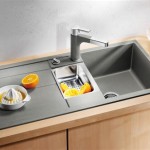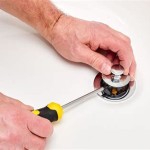Drain Plug Stuck In Sink
A stuck drain plug can be a frustrating plumbing issue, disrupting the smooth flow of water and potentially leading to bigger problems if left unaddressed. Several factors can contribute to a stuck drain plug, ranging from simple buildup of hair and soap to more complex issues like corrosion or a broken linkage mechanism. Understanding the type of drain stopper in the sink is the first step towards effectively resolving the problem.
Drain stoppers come in various designs, each with its unique removal method. The most common types include the pop-up stopper, the lift-and-turn stopper, the push-and-seal stopper, and the toe-touch stopper. Identifying the type of stopper is crucial because attempting to remove one type using the method for another can cause damage.
The pop-up stopper is operated by a pivot rod located behind the faucet. This rod is connected to a clevis strap that lifts and lowers the stopper. A nut secures the pivot rod to the drain pipe. If this type of stopper is stuck, the first step is to disconnect the pivot rod from the clevis strap. This usually involves removing a clip or screw. Once disconnected, the stopper can often be pulled out from the top of the drain.
The lift-and-turn stopper is identified by its twisting motion required to lift and seal the drain. These stoppers are often held in place by a nut located underneath the sink. Accessing this nut might require using a basin wrench due to the limited space. Once the nut is loosened, the stopper can be lifted out.
The push-and-seal stopper operates with a simple push to close and another push to open. These stoppers rely on a spring mechanism. If stuck, they can often be freed by firmly gripping the stopper and rocking it back and forth while pulling upwards. If this doesn't work, access to the underside of the sink might be necessary to check for any obstructions or damage to the spring mechanism.
Toe-touch stoppers are operated by a foot lever located at the back of the cabinet under the sink. A series of connecting rods and springs control the stopper. If this type of stopper is stuck, inspecting the linkage mechanism for obstructions or damage is essential. The problem may lie with a disconnected rod or a broken spring.
Before attempting any removal method, it's crucial to clear the drain opening of any visible debris, such as hair or soap scum. Tools like pliers, a small screwdriver, and a basin wrench can be helpful, depending on the stopper type. Wearing gloves is recommended to protect hands from bacteria and grime.
If the stopper is stuck due to mineral buildup, soaking the stopper in vinegar can help dissolve the deposits. Pouring vinegar down the drain can also address buildup within the drainpipe itself. Allowing the vinegar to sit for 30 minutes to an hour before attempting removal can significantly improve the chances of success.
Pliers can be useful in gripping and removing stubborn stoppers. However, care should be taken not to scratch or damage the sink's finish. Wrapping the pliers' jaws with a cloth can provide a protective barrier. Gentle, persistent pressure is often more effective than brute force, which can damage the stopper or the drain.
For stoppers stuck due to corrosion, penetrating oil can be a helpful aid. Applying the oil to the threaded areas and allowing it to soak for a while can loosen the corrosion and facilitate removal. After applying penetrating oil, always test the stopper's movement before attempting full removal.
If the issue persists after attempting these methods, seeking the assistance of a qualified plumber is recommended. A plumber has the expertise and specialized tools to address more complex issues, such as a broken drain linkage or severely corroded parts. Attempting forceful methods without proper knowledge can lead to further damage and potentially more costly repairs.
Regular drain maintenance can help prevent future occurrences of stuck stoppers. Periodically cleaning the drain with a mixture of baking soda and vinegar can help remove buildup and keep the drain flowing smoothly. Avoiding pouring grease or other substances that can solidify down the drain is also important.
Furthermore, inspecting the drain stopper mechanism periodically for signs of wear and tear can help identify potential issues early on. Addressing these issues proactively can prevent them from escalating into more significant problems requiring extensive repairs.
Proper identification of the drain stopper type, careful application of appropriate removal methods, and regular maintenance are key to resolving and preventing stuck drain plugs. Understanding the mechanics of each stopper type allows for targeted troubleshooting and minimizes the risk of causing further damage to the plumbing system.

How Do I Fix A Stuck Push Down Sink Plug 4 Ways To Free Pop Up

How To Release A Stuck Drain Plug In The Bathroom

Plumbing How Can I Remove The Stopper From My Sink Home Improvement Stack Exchange

How To Fix Stuck Push Sink Waste Spring Drain Plug Bathroom Youtube

Sink Stopper Stuck Super Easy Fix Diy Savings 150

How To Remove A Stopper From The Bathroom Sink Family Handyman

Bathroom Sink Stopper Plug Stuck Down Diy Fix

How To Fix A Stuck Sink Stopper Fast Easy Diy Solutions

How To Fix Stuck Pop Up Sink Plug With Dental Floss

In My Sink Pop Up Stopper The Tip Of Pivot Rod Is Broken How Do I Fix It Home Improvement Stack Exchange







